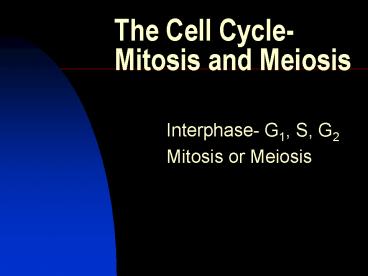The Cell Cycle-Mitosis and Meiosis - PowerPoint PPT Presentation
Title: The Cell Cycle-Mitosis and Meiosis
1
The Cell Cycle-Mitosis and Meiosis
- Interphase- G1, S, G2
- Mitosis or Meiosis
2
The Cell Cycle
- The sequence of growth and division of a cell
3
(No Transcript)
4
Interphase G1, S, G2
- Interphase is when the cell grows, and the
organelles double prior to the actual splitting
of the nucleus. - 93 of a cells life is spent in interphase.
- Interphase has three parts
- Growth 1 (G1)
- Synthesis (S)
- Growth 2 (G2)
5
G1, S, G2
- G1 is when organelles double.
- Remember each new cell needs a complete set of
organelles. - S when DNA is replicated.
- Each cell needs a complete and identical set of
DNA - G2 Proteins needed for Mitosis are produced.
6
Mitosis
- The process by which the cell nucleus divides
into two identical cell nuclei. - In some Human cells interphases lasts 15.3 hours,
while mitosis lasts only .7 hours. - Occurs in a series of steps
- Prophase
- Metaphase
- Anaphase
- Telophase
- Cytokinesis
7
Chromosomes
- Must duplicate and separate during Mitosis
- Structures of the tightly packaged DNA
- DNA is tangled up into a substance of chromatin
- The chromatin is packaged on the chromosome
8
Chromosomal structure
9
Prophase
- Chromosomes now called chromatids because they
doubled to form short thick rods which pair up
and line up in the center of the nucleus. - A centromere connects the two halves of the
doubled chromatids. - Spindle fibers begin to form.
- Spindle fiber a fibrous structure from the
cytoplasm which forms to the centriole. - Centrioles move to opposite sides of the cell.
- The nuclear membrane breaks down.
10
Prophase
11
Metaphase
- Centromeres of the chromatid pairs line up in the
middle of the cell. - Metaphase plate- location where the centromeres
line up in the center of the cell. - By the end of metaphase each chromatid has
attached to spindle fibers.
12
Metaphase
13
Anaphase
- The spindle fibers pull the chromatids apart.
- This separates each one from its duplicate. These
move to opposite sides of the cell. - Now there are two identical sets of chromosomes.
14
Anaphase
15
Telophase
- When the chromosomes reach opposite sides of the
cell the spindle fibers break up. - The nuclear membrane begins to reform.
- A furrow begins to develop between the two sets
of chromosomes.
16
Telophase
17
Cytokinesis
- The two identical cells completely divide and the
cell membrane is completely formed.
18
Mitosis Movie 1
19
Mitosis movie 2
20
Meiosis
- Diploid (2n) - A cell with two of each kind of
chromosome. - One chromosome from each parent.
- If two body cells were to combine nuclei, the
number of chromosomes would double. - In order for sexual reproduction to occur, each
cell involved must reduce its chromosome number
by half. - Haploid (n)- A cell with one of each kind of
chromosome.
21
Haploid cells
- Haploid cells are called gametes
- Gametes are either sperm or eggs
- Organism diploid gamete
- Human 46 23
- Pea 14 7
- Fruit fly 8 4
- Dog 78 39
22
Homologous chromosomes
- Are paired chromosomes with genes for the same
trait arranged in the same order. - Ex. Eye color, hair color, height, one may code
for blue, blonde, tall, its homolog may code for
brown, blonde, short - Homologous chromosomes may have different alleles
on them - Allele- gene form for each variation of a trait
of an organism.
23
Meiosis
- Meiosis is the process of cell division in which
gametes are formed and the number of chromosomes
is halved. So that sexual reproduction and zygote
formation can occur. - Zygote- Fertilized egg which has a diploid number
of chromosomes.
24
Stages of Meiosis
- Interphase-
- Chromosomes replicate
- Each chromosome consists of 2 identical sister
chromatids - Prophase I
- Each Pair of homologous chromosomes come together
to form a tetrad. - Tetrad- 2 homologous chromosomes come together
and the 4 chromatids overlap.
25
Crossing over
- Tetrads are so tight that non-sister chromatids
- from the homologous pair actually exchange
genetic material. - Crossing over- The exchange of genetic material
by non-sister chromatids during late prophase I
of meiosis. - Results in a new combination of alleles
26
Metaphase I
- Homologous chromosomes line up together in pairs.
- In mitosis homologous chromosomes line up in
the middle independently of each other.
27
Anaphase I
- Spindle fibers attach to the centromeres of each
pair. - Homologous chromosomes separate and move to
opposite ends of the cell. - Centromeres DO NOT split like they do in mitosis
- Now each cell will get one chromosome from each
homologous pair.
28
Telophase I
- Spindle fibers break down
- Chromosomes uncoil
- Cytoplasm divides
- Another cell division is needed because the
number of chromosomes has not been reduced - After telophase I there maybe a short interphase,
but not always. It is important to note that if
a cell does have a second interphase, there is No
replication of chromosomes.
29
Meiosis I
30
Meiosis II
- Is basically just like mitosis, but remember the
chromosomes did not duplicate in interphase II. - Prophase II
- Chromosomes begin to line up in the middle of the
cell. - Spindle fibers begin to form
- Metaphase II
- Chromosomes line up on the metaphase plate
31
Meiosis II
- Anaphase II
- Centromeres split
- Sister chromatids separate and move to opposite
sides of the cell - Telophase II
- Nuclei reform
- Spindle fibers disappear
- Cytoplasm divides into two.
- The number of chromosomes in each daughter cell
has now been reduced by half.
32
Meiosis II
33
Meiosis Movie 1































